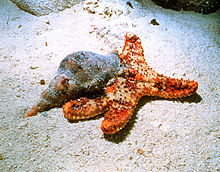Predatory slug

As carnivorous snails are snails referred to as carnivores prey on other animals. The term in German is imprecise as it can refer to both specific species of snail and the ecological group of carnivorous snails as a whole. These include in particular marine species.
Taxa known as predatory snails
In the literature - especially in popular science - the name refers to better-known land snail species such as the tiger snail ( Limax maximus ), snails of the genus Daudebardia such as the reddish predator snail ( Daudebardia rufa ) and the short-footed predator snail ( Daudebardia brevipes ), both of which belong to the Daudebardiidae , but also the brown backpack snail ( Testacella maugei ) from the family Testacellidae . Fencers and falconers use the term for the Oleacinidae family .
Nowadays in the aquarium hobby the “predator snail” is usually understood to mean the robbery tower snail ( Clea helena ) from the family Buccinidae . In the scientific literature, however, the term “predatory snail” is mostly used for the ecological group, for example the marine moon snails (Naticidae).
Loot spectrum

Since slugs move slowly, the prey of predatory slugs is usually slow or sessile as well . In land snails these are mostly annelids ( earthworms , enchytrae ) or snails , in one species ( rectartemon depressus ) also flatworms . In the case of sea snails, it is often cnidarians , moss animals , sponges , sea squirts , polybristles , mussels , snails, barnacles or echinoderms . An exception are some cone snail species , which can catch fish with their poison harpoon , while the spiny snail Drupa ricinus does this without poison. Some species of snail, including the Atlantic triton snail and the Australian moon snail , also prey on decapods ; for the harp snails they form the main food.
Adjustments
Compared to herbivores, carnivorous snail species usually have a much larger mouth area (buccal mass) with a throat and salivary glands. The teeth of the radula are usually sharp and pointy in order to hold the prey in place and to cut out pieces of meat from it. But there are also specialists such as the cone snails and other conoidea (arrow-flickers or poison-flickers), in which radula teeth are designed as "harpoon tips" that are connected to a poison gland.
Nettle-eating snails secrete a mucus so that the nettle capsules of the prey do not explode. The thread snails do not digest them, but store them in their dorsal processes via appendages of their midgut gland and use them as kleptocnides to ward off enemies.
Both moon snails (Naticidae) and many whelks (Muricidae) are able, in the shell of their prey - snails, clams or barnacles - to drill a hole and so to get to the meat of the prey using its radula. Snail species from both - not closely related - families have a special gland, the accessory boring organ (ABO). While the secretions of the ABO serve to dissolve the lime in the spiked snails, the ABO of the moon snails probably only has a sensory function, and the hole is drilled purely mechanically with the help of the radula. Boreholes in the shells that have been eaten empty can be recognized by the fact that they are conical in moon snails and cylindrical in spiny snails. Snails of the superfamily Cassoidea ( helmet snails , barrel snails and conch horns ), on the other hand, dissolve the shell of their prey - mostly echinoderms - with the help of sulfuric acid or aspartic acid as a whole or in one place. Predatory land snails of the genus Poiretia do this in a similar way with the shell of captured snails.
Snail taxa with predominantly carnivorous species (selection)
- Land snails (Stylommatophora)
- Daudebardia (Daudebardiidae)
- Backpack snails (Testacellidae)
- Oleacinidae
- Spiraxidae
- Streptaxidae
- Rhytididae
- Hind gill (Opisthobranchia)
- Star snails (Doridoidea)
- Thread snails (Aeolidioidea)
- Tree snails (Dendronotoidea)
- Spiny snails (Muricidae)
- Turbinellidae
- Fasciolariidae
- Horn snails (Buccinidae)
- Harp snails (Harpidae)
- Olive snails (Olividae)
- Roller snails (Volutidae)
- Cone snails (Conidae)
- Moon snails (Muricidae)
- Triton snails (Ranellidae)
- Helmet snails (Cassidae)
- Barrel snails (Tonnidae)
- Spiral stair snails (Epitoniidae)
- Raft snails (Janthinidae)
literature
- Gareth Owen: Feeding . In: Karl M. Wilbur, CM Yonge: Physiology of Mollusca , Volume 2. Academic Press, New York / London 1966. Chapter 1, I. Gastropoda, pp. 1-24.
Web links
- Carnivorous land snails , sea snails on Weichtiere.at
Individual evidence
- ↑ Achim Paululat, Günter Purschke: Dictionary of Zoology: Animal names, general biological, anatomical. Spectrum of Academic Publishers, Heidelberg 2011. S. 145. Daudebardia f. Gene. The Zonitacea, Stylommatophora. Spec .: D. Rufa, (red) predatory snail.
- ↑ Kosmos Handweiser für Naturfreunde, Gesellschaft der Naturfreunde, Volumes 15-16. Stuttgart 1918. p. 202.
- ^ Robert Lauterborn: 50 years of research on the Rhine: the life and work of a German natural scientist. Lavori, Freiburg i. Br. 2009. p. 185. "The predatory snail Testacella maugei , which is reminiscent of our Daudebardia, lived in the same places ".
- ↑ Heaven and Earth - Volume 27 - page 137. "... the predatory snail Testacella maugei , which lives in southwest Europe, southern Ireland and southwest England.".
- ^ Rosina Fechter and Gerhard Falkner: Molluscs. 287 pp., Mosaik-Verlag, Munich 1990 (Steinbach's Nature Guide 10) ISBN 3-570-03414-3
- ↑ CR Boettger: The location of the drilling site when the predatory snails from the family Naticidae attacked. Journal for Scientific Zoology 136, pp. 453–463, Leipzig 1930.


